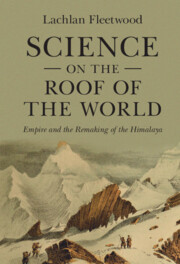
- Cited by 4
-
Cited byCrossref Citations
This Book has been cited by the following publications. This list is generated based on data provided by Crossref.
Acharya, Anushilan Steiner, Jakob F. Walizada, Khwaja Momin Ali, Salar Zakir, Zakir Hussain Caiserman, Arnaud and Watanabe, Teiji 2023. Review article: Snow and ice avalanches in high mountain Asia – scientific, local and indigenous knowledge. Natural Hazards and Earth System Sciences, Vol. 23, Issue. 7, p. 2569.
Hore, Jarrod 2023. Handbook of the Historiography of the Earth and Environmental Sciences. p. 1.
Fleetwood, Lachlan 2023. Histories of habitability from the oikoumene to the Anthropocene. WIREs Climate Change, Vol. 14, Issue. 5,
Armston-Sheret, Edward 2024. Why study the history of exploration?. Dialogues in Human Geography, Vol. 14, Issue. 1, p. 140.
- Publisher:
- Cambridge University Press
- Online publication date:
- April 2022
- Print publication year:
- 2022
- Online ISBN:
- 9781009128117




